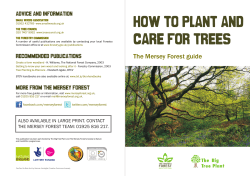
Careful urban tree planting and pruning needed to reduce trapping
Careful urban tree planting and pruning needed to reduce trapping of air pollution 14 February 2015 Issue 403 Subscribe to free weekly News Alert Source: Jin, S., Guo, J., Wheeler, S., Kan, L. & Che, S. (2014). Evaluation of impacts of trees on PM2.5 dispersion in urban streets. Atmospheric Environment 99: 277–287. DOI:10.1016/j.atmosenv.2 014.10.002. Contact: chsq@sjtu.edu.cn sijiaapple@sjtu.edu.cn Read more about: Green infrastructure, Air pollution, Urban environment The contents and views included in Science for Environment Policy are based on independent, peer-reviewed research and do not necessarily reflect the position of the European Commission. To cite this article/service: "Science for Environment Policy": European Commission DG Environment News Alert Service, edited by SCU, The University of the West of England, Bristol. Careful planting and pruning is needed to ensure that air pollution in tree-lined streets is minimised, new research suggests. While planting trees in urban areas can have many benefits, such as enhancing biodiversity, trees can trap particulate matter pollution, say the study’s authors. Particulate matter (PM) air pollution is a component of vehicle exhaust emissions and PM2.5 (particles of up to 2.5 micrometres in size) is linked to respiratory and lung disease, and early death. In the EU, Directive 2008/50/EC on ambient air quality and cleaner air for Europe sets PM2.5 limits and targets for reduction. In places where busy streets are lined by buildings on both sides, creating a ‘street canyon’, traffic emissions can build up. Anything that prevents pollution from escaping could increase the health risks faced by those living and commuting in the area. Therefore, even trees, which are usually planted for their cooling effects as well as benefits for biodiversity and wellbeing, can have a negative impact. In Shanghai, China, the ‘green streets’ programme has been planting trees in urban areas for decades. ‘Green streets’ have tree canopies covering at least half the area of the street below. The researchers monitored PM2.5 concentrations at six sites on two tree-lined Shanghai streets, plus two sites without any trees, which acted as controls. Their aim was to provide information to guide city planners in minimising air quality impacts when planting trees. They monitored PM2.5 concentrations over 12 hours, on a single day in each of spring, summer, autumn and winter. They sampled at four different heights on the pavement side of trees, corresponding to the top, middle and bottom of tree crowns, and 1.5 metres above the ground. They also took samples 0.3 metres above the ground in the middle of the road. Overall, PM2.5 concentrations were higher on tree-lined streets than on streets with no trees, especially at higher sampling positions relative to the trees. However, there were exceptions. In winter, when pollution levels were generally highest, the deciduous trees on one of the streets shed their leaves. This brought winter PM2.5 concentrations on the street close to the same level as PM2.5 concentrations on the control street, which had no trees. The researchers conclude, therefore, that to mitigate winter pollution it is better to plant deciduous rather than evergreen trees. The density of tree canopies and areas they covered, as well as wind speed, were important factors affecting PM2.5 concentrations. The researchers measured lower wind speeds on treelined streets, suggesting that trees prevent air from circulating in street canyons. They also tested the effects of three different tree pruning intensities —‘strong’, ‘weak’ and no pruning— and found that more intense pruning lowered pollution levels via reductions in canopy density and area covered. The researchers suggest that a canopy density of about 50–60% would be optimum as PM2.5 concentrations climb quickly above this figure, but below it, they fall slowly. Therefore, trees could be planted and pruned to optimum density, with little additional impact on air quality compared with lower densities. In Shanghai, for example, this would mean planting normalsized London plane (Platanus acerifola) trees eight metres apart along both sides of a 16metre wide stretch of road, and pruning them intensely. The researchers did not, however, study the negative impacts of pruning on trees, such as reduced cooling and biodiversity.
© Copyright 2025





















